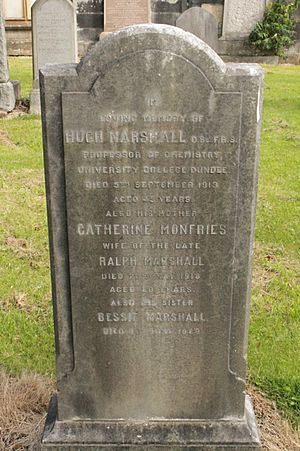Hugh Marshall facts for kids
Hugh Marshall (born January 7, 1868 – died September 5, 1913) was a Scottish chemist. He made important discoveries in chemistry. He is best known for finding a group of chemicals called persulphates in 1891. He also invented a special chemical known as Marshall's acid. In 1902, he suggested a new way to write the equals sign (<chem><=></chem>) in chemistry. This sign is now used to show when a chemical reaction is in balance.
Hugh Marshall: A Pioneer in Chemistry
Hugh Marshall was a brilliant scientist from Scotland. His work helped us understand more about chemical reactions. He was a member of important scientific groups like the Royal Society and the Royal Society of Edinburgh.
Early Life and Education
Hugh Marshall was born in Edinburgh, Scotland, on January 7, 1868. His parents were Ralph Marshall and Catherine Monfries.
He went to school at Moray House Normal School. Later, he studied science at the University of Edinburgh. He earned his first degree (BSc) in 1886. Then, he continued his studies and received a higher degree (DSc) in 1888.
His Amazing Discoveries
Hugh Marshall made two very important contributions to chemistry.
Discovering Persulphates
In 1891, Hugh Marshall discovered a new group of chemicals called persulphates. These chemicals are important in many industrial processes. They are used in things like cleaning products and in making other chemicals.
Inventing Marshall's Acid
He also invented a specific chemical compound known as Marshall's acid. This acid is also called peroxydisulfuric acid. It is a strong oxidizing agent, which means it can cause other chemicals to lose electrons.
The Equilibrium Sign
In 1902, Marshall suggested a new way to write the equals sign in chemistry. He proposed using <chem><=></chem> to show dynamic equilibrium. This is when a chemical reaction is happening in both directions at the same speed. This symbol is now standard in chemistry textbooks and research.
His Career in Academia
After his studies, Hugh Marshall began teaching.
Teaching at Edinburgh University
In 1894, he started lecturing at the University of Edinburgh. He taught subjects like mineralogy and crystallography. These are studies of minerals and how crystals are formed. In 1902, he switched to teaching chemistry.
Becoming a Professor in Dundee
In 1908, he moved to Dundee University College. This college later became the University of Dundee. At Dundee, he became a Professor of Chemistry. This was a very important position.
Recognition and Awards
Hugh Marshall's scientific work was highly respected.
Fellow of Royal Societies
In 1888, he was chosen as a Fellow of the Royal Society of Edinburgh. This is a group of top scientists in Scotland. He even won the Society's Keith Prize between 1899 and 1901 for his excellent work. In 1904, he was also elected a Fellow of the Royal Society of London. This is one of the oldest and most respected scientific organizations in the world.
Later Life
Hugh Marshall passed away in London on September 5, 1913. He was 45 years old. He is buried in Grange Cemetery in south Edinburgh, next to his parents.



